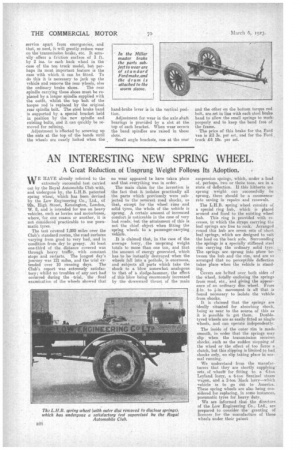AN INTERESTING NEW SPRING WHEEL.
Page 12

If you've noticed an error in this article please click here to report it so we can fix it.
A Great Reduction of Unsprung Weight Follows Its Adoption.
WE HAVE already referred to the extremely successful test carried out by the Royal Automobile Club with, and undergone by, the L.H.B. patented spring wheel, which has been devised by the Low Engineering Co., Ltd., of 92a, High Street, Kensington, London, W. 8, and is intended for use on heavy vehicles, such as lorries and motorbuses, where, for one reason or another, it is not considered practicable to use pneumatic tyres.
The test covered 1,000 miles over the Club's standard routes, the road surfaces varying from good to very bad, and in condition from dry to greasy. At least one-third of the distance covered was through heavy traffic, with constant stops and restarts. The longest day's journey was 121 miles, and the trial extended over 10 running day's. The Club's report was extremely satisfactory; whilst no troubles of any sort had occurred during the trial, the final examination of the wheels showed that no wear appeared to have take-2 place and that everything was in order.
The main claim for the invention is the fact that it isolates practically all the parts which previously were subjected to the severest road shocks, so that, except for the wheel rims and solid tyres, the whole of the vehicle is sprung. A certain amount of increased comfort is noticeable in the case of very bad roads, hut the attainment of this is not the chief object when fitting the spring wheels to a passenger-carrying vehicle.
It is claimed that, in the case of the average lorry, the unsprung weight totals to more than one ton, and that the amount of energy generated, which has to be instantly destroyed when the wheels fall into a pothole, is enormous, and subjects all parts which take the shock to a blow somewhat analogous to that of a sledge-hanuner, the effect of this blow being enormously increased by the downward thrust of the -main
suspension springs, which, under a load of, perhaps, two or three torte, are in a state of deflection. If this hitherto unsprung weight can successfully he sprung, there should be a commensurate saving in repairs and renewals.
The L.H.B. spring wheel consists of a special ring hub, which is placed around and fixed to the existing wheel hub. This ring is provided with recesses, in which the straps carrying the leaf springs are free to rock. Arranged round this hub are seven sets of short leaf springs, which are designed to suit the load on the back axle. Surrounding the springs is a specially stiffened steel rim carrying the ordinary solid tyre.. The springs are sprung into place between the hub and the rim, and are so arranged that no perceptible deflection takes place when the vehicle is standing. Covers are belted over both sides of the wheel, totally enclosing the springs from mud, etc., and giving the appearance of an ordinary disc wheel. From to On. movem,ent is all that is found necessary to isolate the vehicle from shocks.
It is claimed that the springs are ideally situated for absorbing shock, being as near to the source of this as
it is possible to get them. Doubletyred wheels are as easily fitted as single • wheels, and can operate independently.
The inside of the outer rim is made. smooth, in order that the springs may slip when the transmission receives shocks, such as the sudden stopping of the wheel or the effect of too fierce a clutch, but this slipping is limited to bad shocks only, no slip taking place in normal running.
We understand from the manufacturers that they are shortly supplying seta of wheels for fitting to a 4-ton Leyland lorry, a 6-ton Sentinel steam wagon, and a 2-ton Mack v vehicle is to go Out to America. These spring wheels are also being considered for replacing, in some instances, pneumatic tyres for heavy duty. We are informed that the directors of the Low Engineering Co., Ltd., are prepared to consider the granting of licences for the manufacture of these wheels under their patent




























